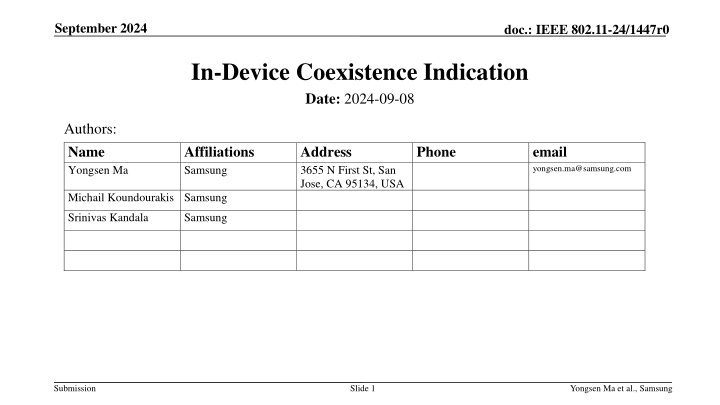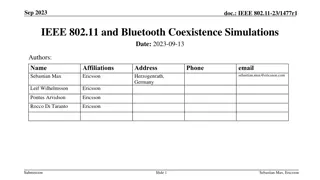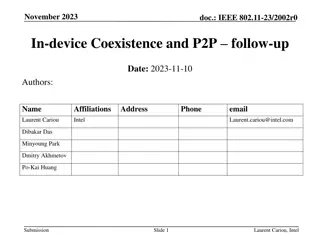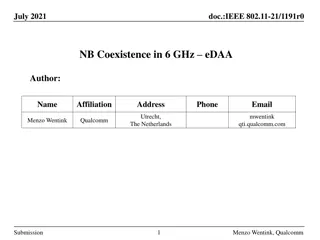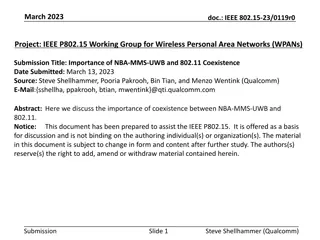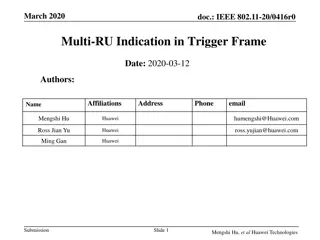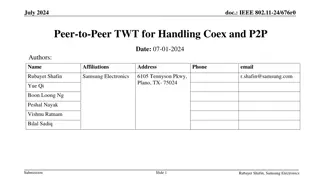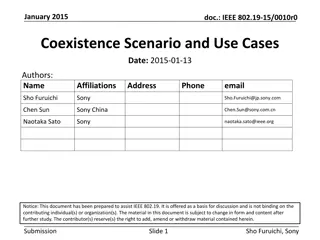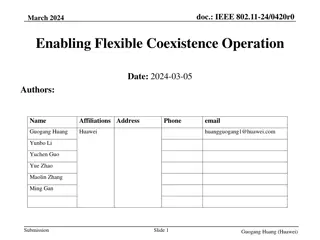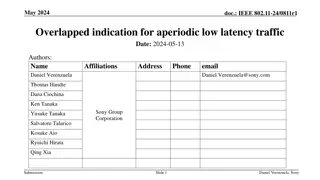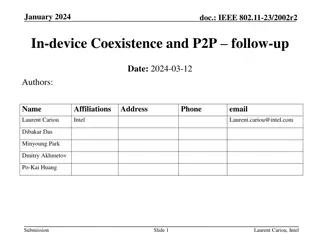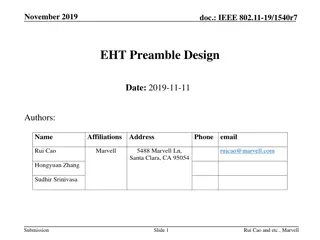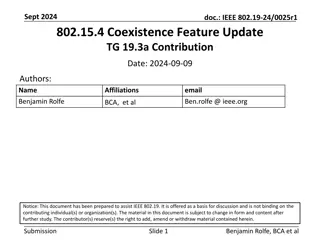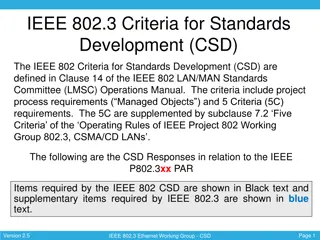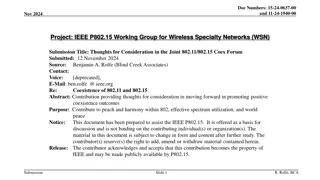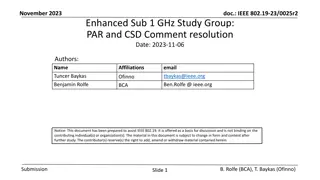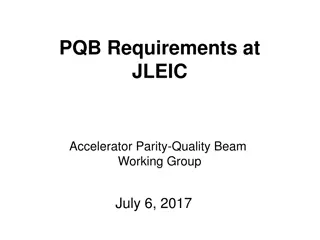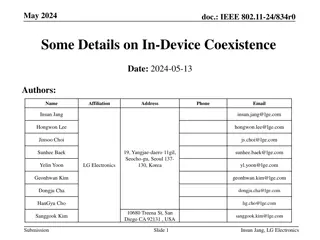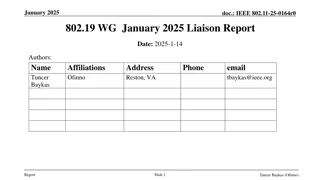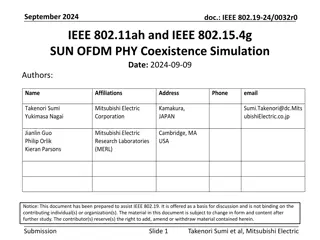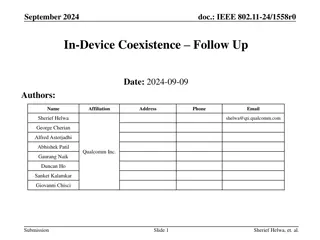Proposal for In-Device Coexistence Indication in IEEE 802.11-24
This document presents a proposal for non-AP STAs to indicate in-device coexistence activities, providing both coarse-grained and fine-grained unavailability information. The aim is to assist APs and other STAs in identifying the presence of in-device coexistence activities at TXOP level, enhancing network efficiency and performance.
Download Presentation

Please find below an Image/Link to download the presentation.
The content on the website is provided AS IS for your information and personal use only. It may not be sold, licensed, or shared on other websites without obtaining consent from the author.If you encounter any issues during the download, it is possible that the publisher has removed the file from their server.
You are allowed to download the files provided on this website for personal or commercial use, subject to the condition that they are used lawfully. All files are the property of their respective owners.
The content on the website is provided AS IS for your information and personal use only. It may not be sold, licensed, or shared on other websites without obtaining consent from the author.
E N D
Presentation Transcript
September 2024 doc.: IEEE 802.11-24/1447r0 In-Device Coexistence Indication Date: 2024-09-08 Authors: Name Yongsen Ma Affiliations Samsung Address 3655 N First St, San Jose, CA 95134, USA Phone email yongsen.ma@samsung.com Michail Koundourakis Samsung Srinivas Kandala Samsung Submission Slide 1 Yongsen Ma et al., Samsung
September 2024 doc.: IEEE 802.11-24/1447r0 Abstract There are proposals for an non-AP STA to indicate/report unavailability, for example due to P2P transmissions, power save, and in-device coexistence activities [1-13] There are proposals for a non-AP STA to report aperiodic unavailability [1-6] and periodic unavailability [7-9] Motion approved to include in the 11bn SFD: define a mechanism for a non-AP STA to report unavailability at TxOP level and define or reuse/update existing mechanism for a non-AP STA to report long term (periodic) unavailability [13] This submission presents a mechanism for a non-AP STA to report coarse-grained and fine- grained unavailability information It helps AP and other STAs infer whether the non-AP STA has in-device coexistence activities at TXOP level, especially when the non-AP STA is the TXOP responder. Submission Slide 2 Yongsen Ma et al., Samsung
September 2024 doc.: IEEE 802.11-24/1447r0 Introduction 802.11be D7.0 defines one bit to indicate that there may be in-device coexistence activities for EML operation [13] EML Operating Mode Notification frame => EML Control field => In-Device Coexistence Activities subfield There are requests to extend the in-device coexistence indication for NSTR or generic operations [14] There are proposals in TGbn to indicate unavailability for a non-AP STA by defining new mechanism or reusing exiting mechanism Control frame: Multi-STA BlockAck [1, 3, 4, 10], RTS [10], BAR [10] Trigger frame: MU-RTS [3, 10], MU-BAR [10], BSRP [3, 10] A-Control [3] Information Element: TWT [7, 8, 9] New frame/field/subfield/type/subtype/element Submission Slide 3 Yongsen Ma et al., Samsung
September 2024 doc.: IEEE 802.11-24/1447r0 Proposal: Two Levels of In-Device Coexistence Indication Coarse-grained unavailability information Mostly long-term for future TXOP(s) Basic info: to indicate that a non-AP STA may have or does not have in-device coexistence activities Low overhead: one bit, and optionally more bits for coarse timing information, cross-link indication, IDC types, certainty of existence/non-existence of IDC activities To define new mechanism or reuse existing mechanism such as OMN, TWT, TTLM, BA Fine-grained unavailability information Mostly short-term for the current TXOP, and also for future TXOP(s) More details and more accurate info: to indicate that a non-AP STA has or does not have in-device coexistence activities, mostly at the beginning of the TXOP in ICF/ICR One bit, and optionally more info, e.g., fine timing information, for the current and future TXOPs To define new mechanism or reuse existing mechanism such as MU-RTS, MU-BAR, BSRP The coarse and fine unavailability information can be used separately and independently. Submission Slide 4 Yongsen Ma et al., Samsung
September 2024 doc.: IEEE 802.11-24/1447r0 Motivation of the Proposal The proposal is built on top of 802.11be D7.0: an AP MLD may infer a non-AP MLD has in- device coexistence events by EML Operating Mode Notification frame and initial Control frame If an AP MLD has received EML Operating Mode Notification frame with the In-Device Coexistence Activities subfield of the EML Control field set to 1 from a non-AP MLD, and the AP MLD does not receive a response to an initial Control frame that it transmits to the non-AP MLD, then the AP can consider the nonresponse as a result of the in-device coexistence events at the non-AP MLD on the link where the frame was transmitted. The AP is recommended to consider the in-device coexistence indication and select appropriate transmission parameters and methods for the non-AP MLD. and extend it to report two levels of unavailability information Long-term, coarse IDC information in OMN/TWT or other frames Short-term, fine IDC information in ICF/ICR or other frames Submission Slide 5 Yongsen Ma et al., Samsung
September 2024 doc.: IEEE 802.11-24/1447r0 Potential Issues and Resolutions Potential issues when IDC indication is sent too early or too late If sent too early: IDC information may change, e.g., due to TSF, schedule, or priority changes Information may not be used, e.g., no overlapping between IDC activities and TXOP Aperiodic/unpredictable IDC activities: hard to announce accurate information in advance May provide inaccurate information and introduce extra overhead If sent too late: Unpredictable for when TXOP is granted for transmission between the non-AP STA and AP IDC info may not be usable, e.g., switch delay or IDC activities happening when ICF/ICR is sent, especially when the non-AP STA is the TXOP responder The combination of coarse and fine unavailability information helps avoid the potential issues and helps the AP determine if transmission failure is due to link quality or coexistence activities. Submission Slide 6 Yongsen Ma et al., Samsung
September 2024 doc.: IEEE 802.11-24/1447r0 Procedures When the AP obtains TXOP (Optional) The AP checks if it got history IDC indication from the non-AP STA(s) (Optional) The AP requests the non-AP STA(s) to report IDC indication for the current TXOP, and optionally for future TXOP(s) The AP sends ICF to the non-AP STA(s) to request for IDC information The AP waits for ICR from the non-AP STA(s) The AP receives short-term IDC indication from the non-AP STA(s) for this TXOP and long-term IDC indication for future TXOP(s), or the AP does not receive ICR from certain non-AP STA(s) Depending on what IDC indication the AP receives, the AP selects transmission methods and parameters to initiate or terminate transmissions with the non-AP STA(s) In addition to ICF/ICR, the AP/non-AP STA may request/report IDC information in other frames and/or on other link(s). Submission Slide 7 Yongsen Ma et al., Samsung
September 2024 doc.: IEEE 802.11-24/1447r0 Example 1: MU Use Case STA1/STA2 gets TXOP and sends IDCI to AP to indicate that STA1/STA2 may have IDC activities during future TXOP(s), respectively AP gets TXOP and sends ICF to STA1 and STA2 AP does not receive ICR from STA1 AP receives ICR from STA2 indicating that STA2 does not have IDC activities during this TXOP AP initiates transmissions with STA2 IDCI: sent from non-AP STA to AP for coarse IDC information ICF: sent from AP to non-AP STA to request for fine IDC information ICR: sent from non-AP STA to AP to report fine IDC information Submission Slide 8 Yongsen Ma et al., Samsung
September 2024 doc.: IEEE 802.11-24/1447r0 Examples for Coarse/Fine IDC Indication with 1 Bit ** May have other actions based on additional information, e.g., PM bit. * May have capability and timeout settings to determine if received successfully. Long-term, coarse IDC indication Short-term, fine IDC indication Actions for the AP as TXOP holder ** IDC indication received by AP * Coarse IDC indication value ICF sent and ICR received by AP * Fine IDC indication value Infer that the non-AP STA is available or not Transmit/retransmit with the non-AP STA no N/A no N/A available (baseline) yes no N/A yes N/A available (baseline) yes 0 available no N/A yes yes 1 unavailable no N/A yes no 0 available yes no N/A yes 0 available yes yes N/A yes 0 available yes 0 yes yes yes 0 yes 1 unavailable no yes 1 no N/A unavailable no 1 yes available/unavailable yes/no yes N/A 0 available yes 1 yes yes 1 unavailable yes 1 yes no Submission Slide 9 Yongsen Ma et al., Samsung
September 2024 doc.: IEEE 802.11-24/1447r0 Options for Signaling Coarse unavailability information: One bit to indicate that there may be in-device coexistence activities Optionally additional bit to indicate that the non-AP STA has no in-device coexistence activities Optionally additional bits to indicate coarse timing information (start time, periodicity, timeout), IDC types, cross-link indication, certainty of existence/non-existence of IDC activities, etc. Fine unavailability information: One bit to indicate that the non-AP STA has or does not have in-device coexistence activity in the current TXOP Optionally additional bits to include more info such as fine timing information and for future TXOP(s) If the AP cannot infer if the non-AP STA is available from coarse/fine unavailability indication: The AP may adjust the queue/user priority to transmit/receive with other non-AP STA(s), or retransmit with the non-AP STA until certain condition is met The non-AP STA may recommend parameters, e.g., certain number of retries, to the AP Submission Slide 10 Yongsen Ma et al., Samsung
September 2024 doc.: IEEE 802.11-24/1447r0 Conclusion This submission presents discussions on in-device coexistence indication A non-AP STA may report coarse-grained and fine-grained unavailability information. The coarse-grained and fine-grained unavailability information may have one bit to indicate the existence/non-existence of in-device coexistence activities, and optionally more subfields for coarse/fine timing information, cross-link indication, in-device coexistence types, certainty of existence/non-existence of in-device coexistence activities, etc. It helps other STAs infer whether the non-AP STA has in-device coexistence activities at TXOP level, especially when the non-AP STA is the TXOP responder. Submission Slide 11 Yongsen Ma et al., Samsung
September 2024 doc.: IEEE 802.11-24/1447r0 References [1] 802.11-24/0543r1, Coexistence Protocols for UHR - follow up, Sherief Helwa [2] 802.11-24/0675r1, In-device Co-ex and P2P--Follow up, Rubayet Shafin [3] 802.11-24/0834r0, Some Details on In-Device Coexistence, Insun Jang [4] 802.11-24/0857r0, ICR consideration, Liwen Chu [5] 802.11-24/0856r0, Further Discussions on In-Device Coexistence, Jeongki Kim [6] 802.11-24/0806r0, Multi-link In-device Coexistence Management, Juseong Moon [7] 802.11-24/0831r0, Periodic IDC use cases and considerations for signaling, Hongwon Lee [8] 802.11-24/1108r0, Periodic IDC signaling for Mobile AP, Hongwon Lee [9] 802.11-24/1109r0, More consideration for in-device-coexistence, Hongwon Lee [10] 802.11-24/1126r1, ICF-ICR Discussion for DPS, GeonHwan Kim [11] 802.11-24/0504r0, Considerations of A Unified Initial Control Frame Design, Hanqing Lou [12] 802.11-24/0505r0, Considerations of Transmissions of Initial Control Response frames, Hanqing Lou [13] 802.11-24/0171r13, tgbn-motions-list-part-1, Alfred Asterjadhi [14] IEEE P802.11be/D7.0 [15] 802.11-24/0366r0, Proposed resolution to 11be initial SA ballot CID on EMLSR co-ex indication, Qi Wang Submission Slide 12 Yongsen Ma et al., Samsung
September 2024 doc.: IEEE 802.11-24/1447r0 Backup Flow chart for AP Flow chart for non-AP STA Submission Slide 13 Yongsen Ma et al., Samsung
